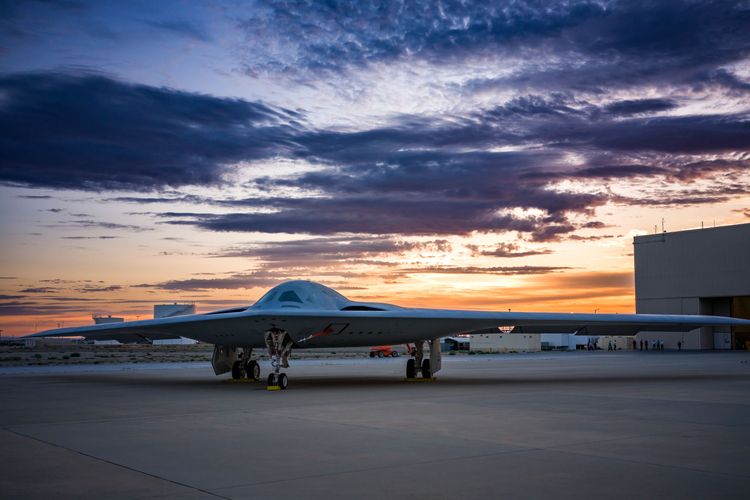The first B-21 Raider has begun taxi tests, in preparation for a first flight by the end of the year, the Air Force confirmed Oct. 25.
The B-21 “is conducting ground taxi activities,” an Air Force spokesperson told Air & Space Forces Magazine in response to a query. The War Zone first reported the development.
“Rigorous testing is a critical step in the B-21 flight test program,” she said. “Extensive testing evaluates systems, components, and functionalities. This testing allows us to mitigate risks, optimize design, and enhance operational effectiveness.”
The spokesperson had no other details to offer and said no photography is planned by the Air Force at this point.
The most recent photos of the first B-21 at Northrop Grumman’s facility at Air Force Plant 42 in Palmdale, Calif., showed the aircraft outside its hangar, presumably for outside engine runs, but the labyrinth of buildings at the plant make it possible for the aircraft to be outside and not visible from local roadways.
Social media sites that monitor Plant 42—where Lockheed Martin and Boeing also have facilities and where novel aircraft and modifications often show up unexpectedly—have been buzzing about “something moving” at Northrop’s end of the plant for two days.
Taxi tests indicate the airplane has already conducted a series of outdoor engine runs. A taxi test campaign typically follows a pattern wherein ground-handling qualities are tested and evaluated at slow and medium speeds before high-speed tests, which are the direct precursor to first flight.
In July, Northrop Grumman officials disclosed the B-21 had accomplished its first “power on” test. In September, Air Force Global Strike Command boss Gen. Thomas A. Bussiere announced the bomber has begun engine runs as part of its ground testing program.
Especially with a large flying wing like the B-21, high-speed taxi tests could inadvertently lead to a first flight. When the YF-16 was making a high-speed taxi test in January 1974, the eager aircraft made an unplanned takeoff.
Air Force officials have said they do not plan to make a media event out of first flight, insisting the bomber will fly as soon as it is ready to do so.
The B-21 was originally expected to fly in 2022 but did not roll out until December of last year, and first flight was then projected for the middle of 2023. In March, Air Force Secretary Frank Kendall said the airplane will fly “by the end of 2023,” but service officials have insisted the event will be driven by technical readiness and not the calendar.
The B-2—the B-21’s predecessor—flew nine months after its rollout in 1988.
The aircraft now taxiing is one of six known to be in some stage of production, and has been described as production-representative. The B-21s are being built on production tooling, and the first examples shouldn’t be considered prototypes, Northrop Grumman aeronautics president Tom Jones said at AFA’s Air, Space and Cyber conference in September.
“The jet that’s going to fly this year, for all intents and purposes, is a production jet,” Jones said during a B-21 panel discussion. “It’s got all the coatings, it’s got the mission systems, it was built using factory processes … with regular workers, by regular factory technicians, not engineers doing a bespoke first article.”
While the first one to fly will be a “flight sciences” aircraft—meaning it has been instrumented to collect data on all aspects of the aircraft’s performances—the B-21 contract calls for configuring all test aircraft as operational models after testing is concluded.
Northrop Grumman CEO Kathy Warden, in a company quarterly earnings call in January, told reporters she expects the contract for low-rate initial production this year, but after first flight. At the second-quarter call, she reported that the first B-21 had completed its first “power on” test, paving the way for engine runs and taxi.
In both calls, Warden cautioned that the fixed-price nature of the LRIP contract, coupled with the inflation of recent years, means there won’t be any profit on the program during that phase, but that Northrop expected to receive a $60 million payment from the Air Force to mitigate inflation and smooth the way toward first flight.
Northrop’s third quarter earnings call is scheduled for Oct. 26

